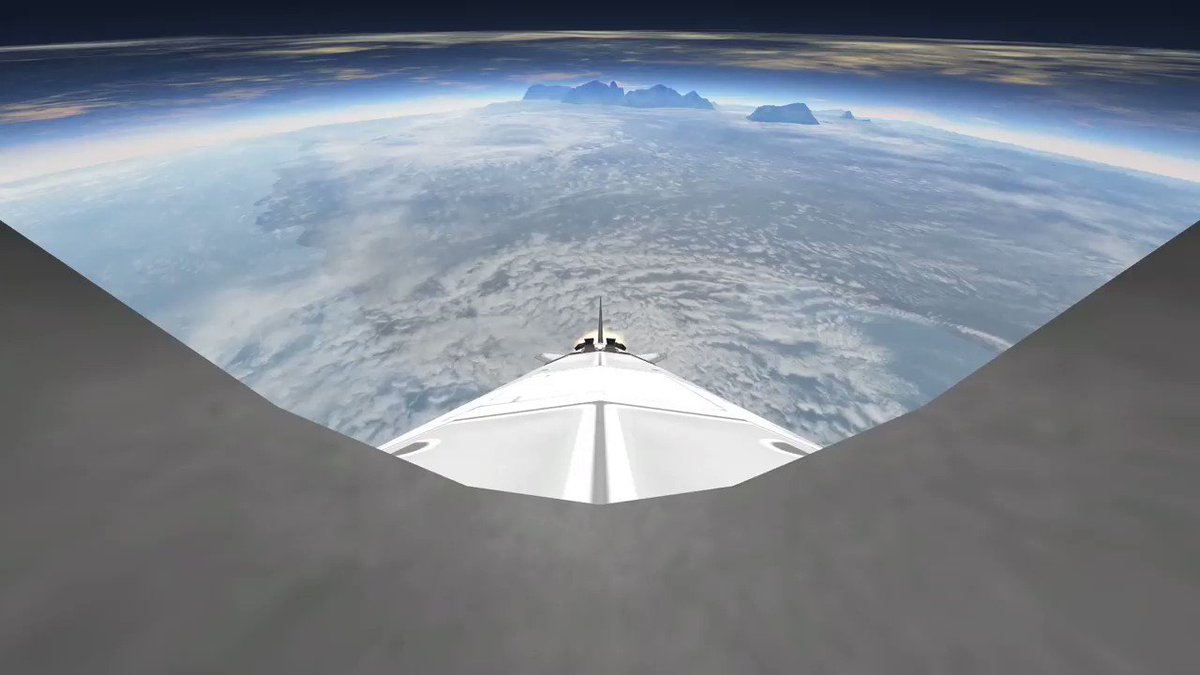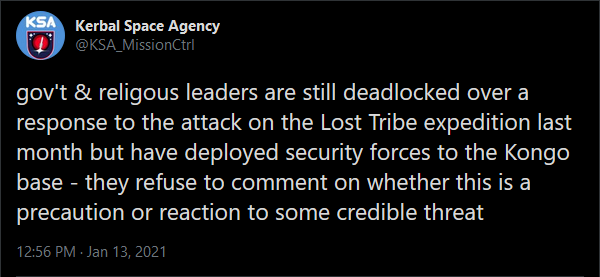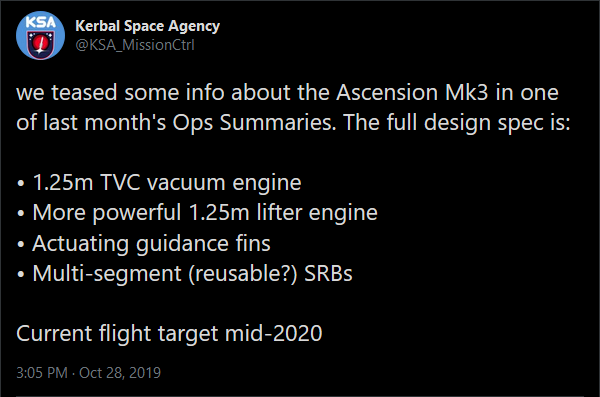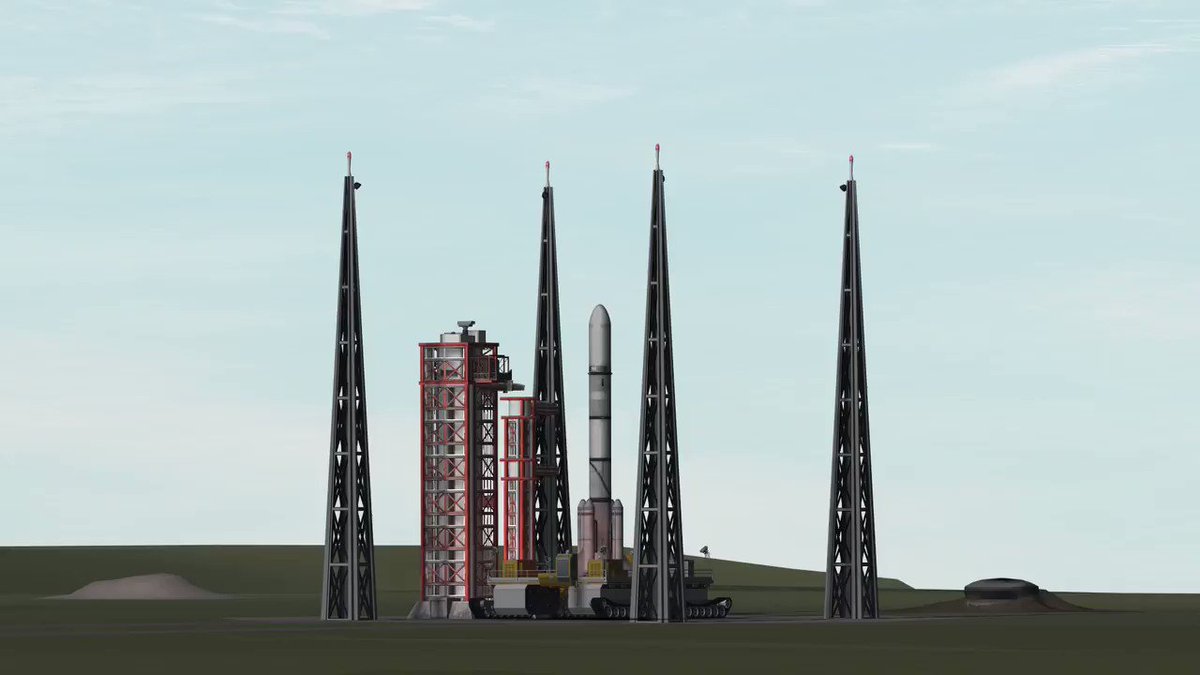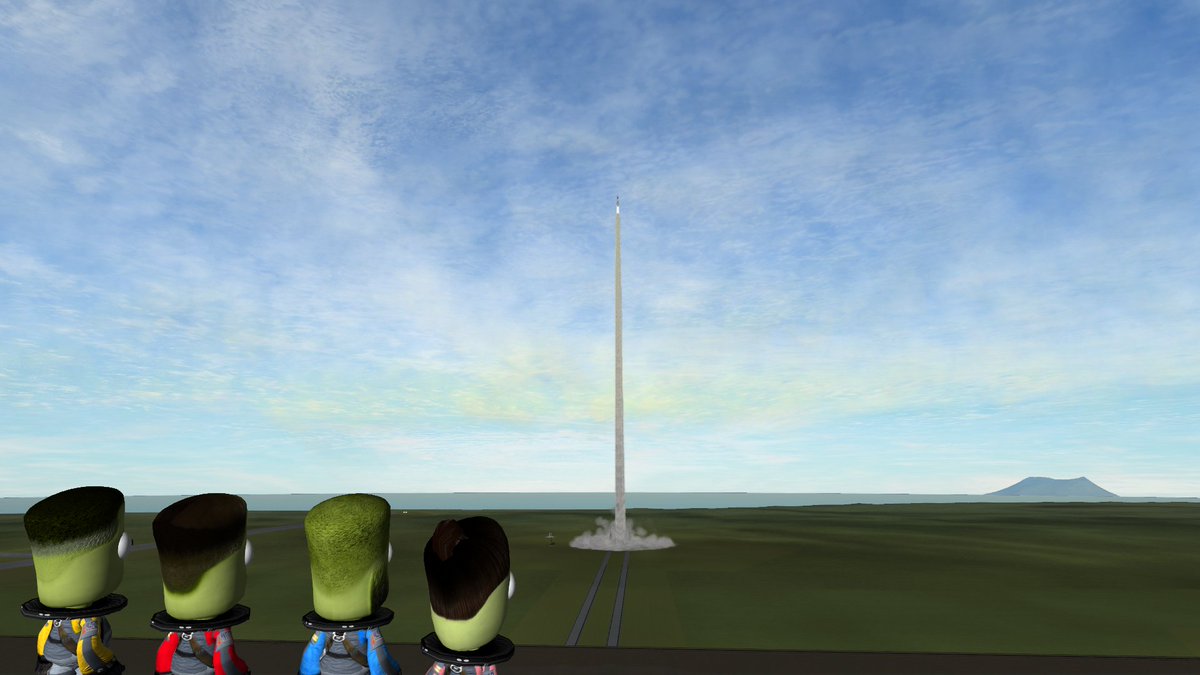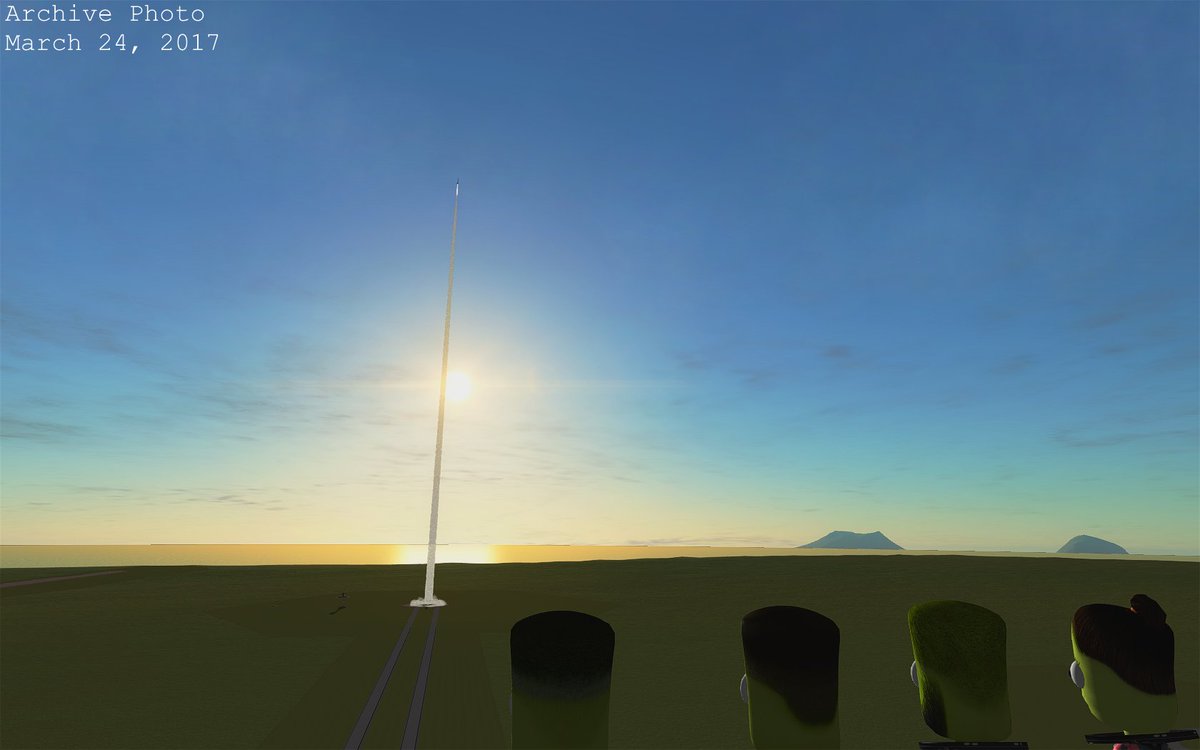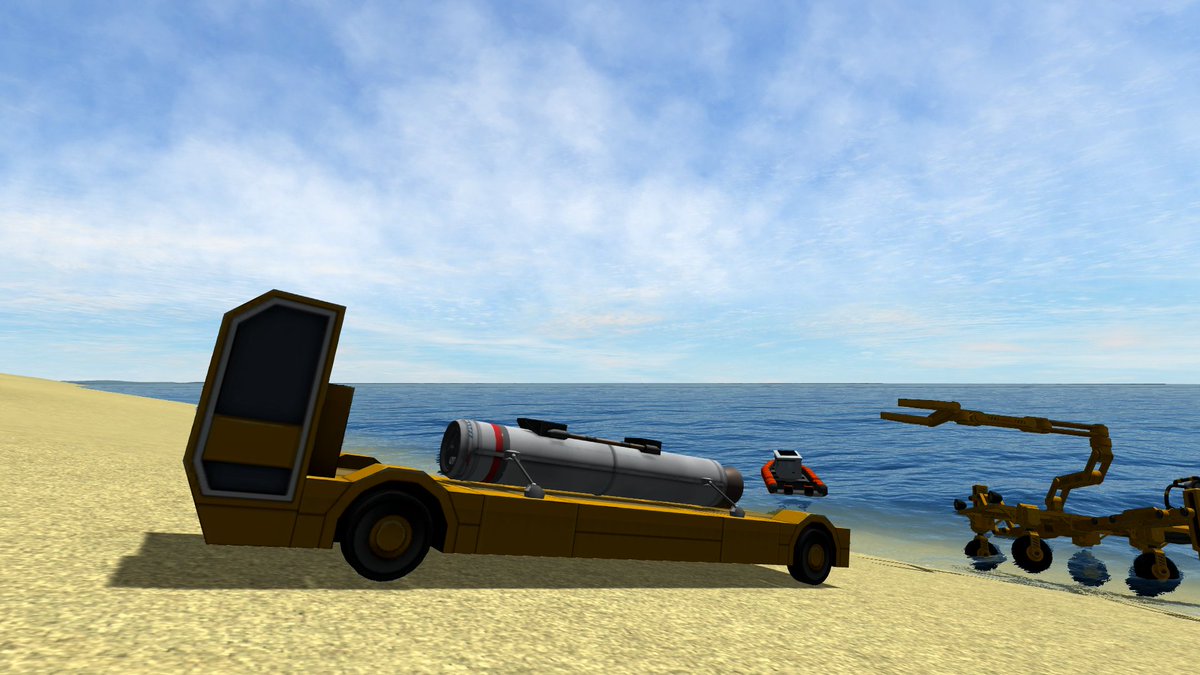|
Progeny Mk6 Block II Debuts
Over half a year since it was first announced (then designated the Mk5), the more powerful version of the Mk6 has at last taken flight this past week. A lot of work went into modeling the rocket’s ascent based off data collected over the numerous Mk5 and Mk6 Block I flights this past year and for the first time engineers were relatively confident that the rocket would perform as expected. Their confidence was proven right as the longer rocket remained pointing downrange after launch thanks in part to the extra push from its radial boosters. The only real surprise was the recovery, since all of the simulations ran before the flight had the rocket either completely breaking up or traveling too fast to safely deploy its chutes. A lot of analysis will need to be done on this flight to determine how we want to proceed such as why the rocket became so unstable late into the flight, whether trying to broadside the atmosphere on purpose would help with recovery from higher altitudes and whether we can even support a mission higher than 1Mm due to battery power limitations. It’s estimated based on this flight’s performance that the Block II could reach out as far as 3.5Mm (1/3 the way to Mun) which would take almost three hours for it to return to Kerbin! We’re not going to put a kuudite RTG on a rocket that will come crashing back into the planet. Although recovery of the reusable parts from this last flight could allow us to launch the next rocket as early as next week, we are currently looking at no sooner than the beginning of July to take more time to consider these issues.
The highlight of the mission was definitely the achievement of passing through the region of hazardous radiation and back into a more “normal” environment in the space beyond. There will be more details in the flight analysis report but the Interstellar Exploration Foundation has already recognized the accomplishment and awarded us the full bounty of 25,000 funds, which will help us fly additional Block I and Block II missions to further explore and define the radiation conditions above the planet.
Ascension Prepares for Capsule Testing, Next Launch
Two capsule prototypes that arrived this week have been getting ready in the VAB to be dropped from low-altitude balloons next week to test their pressure systems, see how they behave in free fall and to test deployment of the new triple canopy parachute that will come out of a nose cone case. The chute casing will be slightly smaller than a normal nose cone that would cap off the capsule because over top of the chute will rest the Launch Escape System, which is still under development and will be tested with the final capsule design later this year. If the capsule recovery goes well over land the float collars will be installed for another test later in the week out at sea. All four of our astronaut trainees will be on hand to help with the testing although at this time none of them will be in the capsules, just a sandbag dummy.
In additional news, the flight analysis for the first Ascension Mk1 launch has finally been released. Several aspects of the flight needed some careful review to determine what happened and how we can address things for the next launch, now scheduled for 7/17 @ 16:36 UTC.
Damage Delays Airborne Rocket Testing
An unfortunate accident occurred in the HAB while the Progeny Mk1-B rocket was being mounted to the top of the Deuce aircraft so it could perform a captive carry and release test at the end of the week. Assessment of the damage to both the rocket and aircraft have turned up no major issues that will require parts to be replaced, but some minor repairs will be needed that will also need to be inspected closely afterwards. All told, Lead Engineer Simon has estimated at least a week, maybe more, before the rocket can again be mounted properly onto the Deuce. In the meantime, Aldeny and Tedman will have to flip a coin to see who gets to take out a Civvie for pollen gathering measurements next week.
Mystery Goo Remains Mysterious
A goo sample was flown last week on a high-altitude balloon up nearly 24km and returned in a state of suspended animation much like the goo that flew up to just 16km. This time however scientists knew it could come back to life and kept it closely monitored in the lab. While the bacteria making up the goo did show signs of activity after four days it never fully recovered to a healthy state and eventually truly died off. Scientists want to know if the longer exposure was the only reason this goo sample died while the other was able to recover and are planning a more thorough study to be conducted next week.
Extremis Opts Out of 2018-2019 Launch Window
The first mission for Extremis will now launch no earlier than September 2019 as trajectory analysis for routes that would lead probes past Urlum and Neidon (even separately) in addition to visiting some of the inner planets have come up unfeasible. The pace of progress towards orbital flight and our ability to get a probe on a path out of the system is also proceeding slower than originally planned so it’s likely even if we had a launch date for the next year we probably couldn’t make it all work in time. Astrodynamicists are now churning through flyby combinations for dates between September 2019 and 2020.
ATN Database
The weekly update for the Asteroid Tracking Network database is available here, containing 2,116 asteroids and 6 updated with new observation data.
From the Desk of Drew Kerman
Out of Character Behind the Scenes stuffWritten on 6/8/18
Had to fight a bit with allergies and also overcoming the extra work required for the Block II launch which again pushed me into many new areas and required a ton of new assets. So I didn’t lose time but haven’t gained any time either, which isn’t that great because I will be gone almost all next week and unable to do any more work so I need to crunch out as much as I can before then because it’ll be right back to playing catch up when I get back. I’m starting to get a bit bummed out that I don’t have the spare time to work on new Ops Tracker features – I really want to get real-time telemetry streaming working but just keeping up with the day-to-day is tough especially when I have to try and bang out 2-3 days instead of just one so I can build up my lead time.
Lead time is important
I have numerous examples of why it’s important to maintain 2-3 weeks of lead time, at least, but the latest was this past week when I was writing tweets for the Block II launch and realized I never considered how many fuel trucks would be needed to handle the extra fuel in the rocket. A check of the truck’s fuel tanks in the game showed I was okay, but it made me think about the Ascension rocket as well for the first time. Checking that, I realized two trucks as depicted in one of the pre-launch photos would not have sufficed, so I added the tweet about making two trips to the launch pad. So it’s not just the fact that I can sit back for a few days and not have to worry about things not being tweeted, I can actively go back and edit improvements to things I’ve already written but not yet published. That’s generally how writing works so the ability to do that is crucial.
Feedback is also important
Another example of why I like people engaging with the KSA would be this tweet from former KSP developer Nova Silisko. I honestly hadn’t remembered to factor the Monolith into the upcoming launch because I knew it wasn’t going to do anything, but I had forgotten that no one else knew it wasn’t going to do anything. This is a case of me not staying inside the mind of the audience. Again my lead time allowed me to edit in some mentions about the Monolith in relation to the Ascension Mk1.
I’d also like to commend Nova for this tweet as well. It’s great to see that some followers have been able to pick up on some of the nuance that I’ve been trying to portray in regards to the Monolith. Yes, it caused a lot of death and destruction but was that really its purpose?
Block II launch
I did a good deal of in game testing prior to actually flying a real mission with this launch, because enough data would have been collected from previous flights that engineers could by now begin to model how a rocket of a similar design would behave. Back in the early days of the Progenitor program I was literally just putting them out on the launch pad, lighting them off to see what would happen, and then writing about it. It’s what I’m doing for Ascension rockets but for Progeny rockets I can start “modeling” flights more.
The launch almost featured another problem in the rocket being unstable in the early flight stage, but then I realized I had just forgotten to remove the fuel tanks automatically assigned to the radial booster nose cones from 3 out of the 4 on the rocket so it was literally unbalanced.
All of my testing did actually show the rocket being unrecoverable after re-entry, so I was actually really totally amazed with how things turned out during the actual mission! It’s great that the game can still offer up surprises like that.
I still hate doing videos. I don’t know if it’s just the way I have things setup but my capture always has tons of little stutters in it that I have to go in and edit out by hand. I had to remove 88 individual frames from the booster detachment video. Here is what it looks like in its raw unedited form.









